Author:
Lekun Lin, Staff Wireless Systems Architect, IDT
Date
09/01/2010
Power amplifier (PA) efficiency is a key factor in wireless system design. Due to the inherent nonlinearity of the PA, a large signal would be distorted and its spectrum would be broadened to disturb its adjacent signals. To keep the input signal in a linear region, we have to reduce the input signal level, which causes low PA efficiency. To achieve high PA efficiency, many PA linearization solutions are proposed. Among them, the solutions attracting the most attention include feed-forward linearization, Cartesian feedback, digital pre-distortion and power supply control schemes. In this article, we introduce and compare these methods. By examining the complexity and performance trades-offs, we recommend guidelines for practical system implementation.
Instead of simple power back-off, a conventional PA linearization method is feed-forward linearization. A typical feed-forward linearization system is shown in Figure 1, where the PA gain is G, the attenuation of the attenuator is 1/G, and PA2 is an auxiliary PA with a gain of G. Here, s denotes the input signal, s1 denotes the PA output, s2 denotes the attenuator output, and s3 denotes the output of the entire linearization system.
The idea of feed-forward linearization is simple: attenuate the PA output, s1, to the same level of the input signal, s, s2 = s1/G; and then obtain the distortion by comparing s2 with the input signal, s, e = s-s2 = s-s1/G. With the auxiliary PA, the distortion can be amplified and subtracted from the original PA output. s3 = s1+e*G = s1+(s-s1/G)*G = G*s; Although feed-forward linearization is stable and has potential high performance, it suffers from high cost and poor power efficiency of the entire scheme since an auxiliary PA is needed.
Feedback methods are also used to achieve PA linearization. Multiple types of feedback methods exist, including envelope feedback, polar feedback and Cartesian feedback. Among them, Cartesian feedback is most widely studied. In Cartesian feedback linearization, shown in Figure 2, the distorted PA output is fed back through an I-Q demodulator to build two negative feedback loops. The major issue of Cartesian feedback is to keep feedback phase alignment, i.e. keep ? being zero. The feedback phase misalignment would compromise the system stability. Cartesian feedback has multiple advantages. The PA model is not necessary to be characterized in Cartesian feedback, and it is simple and robust to PA drift and aging.
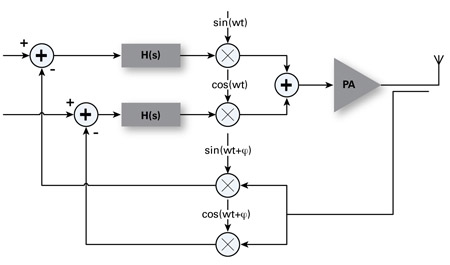
Among all PA linearization methods, digital pre-distortion (DPD) is one of the most efficient methods. It uses a nonlinear digital predistorter in baseband to compensate the distortion introduced by the nonlinear PA. With a digital predistorter, a PA is able to work at the nonlinear region without performance loss, and therefore improve the efficiency. Conventional digital predistorters focus on memoryless PAs, where the PA outputs only depend on current PA inputs. This kind of DPD could be implemented with a look-up table utilizing the PA feedback signal. In recent years, wide-band systems are deployed to pursue high throughput, such as WiMAX and LTE. The memoryless PA model is no longer suitable in wideband systems. The DPD design has to consider the memory effect of PA. Studies showed that the memoryless DPD suffers significant performance degradation when compensating a PA with memory effects. The key part in DPD design is to calculate the coefficients used in predistorters. Among the current literature, two types of approach are studied, i.e., direct learning structures and indirect learning structures. The direct learning structure is depicted in Figure 3, where the coefficients of the digital predistorter are adaptively adjusted to minimize the error between the digital predistorter input and the PA output. In direct learning structure, the PA model should be identified before adjusting the predistorter coefficients. Instead of adaptive coefficient adjusting, the predistorter coefficients could be calculated by inversing the PA model. However, obtaining the inverse of a nonlinear system with memory is generally a difficult task.
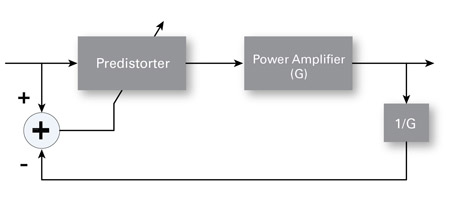
Another type of approach is to use the indirect learning architecture. As shown in Figure 4, a predistorter training block is used in the feedback path to compensate the PA output. The predistorter training block is adaptively adjusted to minimize the error between the PA input and the predistorter-training output. Once the adaptation completes, it is copied before the PA as a digital predistorter. The advantage of the indirect learning structure is that it eliminates the need for PA model identification.
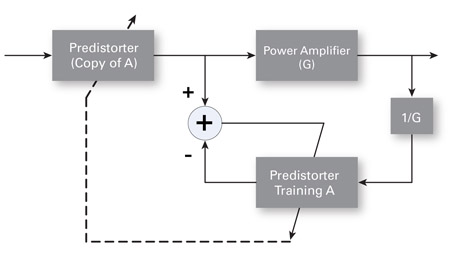
In a real application, the RF analog impairment must be considered in DPD design. Some analog impairment, such as I/Q imbalance, would degrade DPD performance. Since digital predistorter would introduce nonlinear distortion, which has wider bandwidth than the signal, the analog circuit should be able to deal with the wide bandwidth.
By controlling the power supply of PA to reduce thermal dissipation, power supply control schemes are potentially offering the highest power efficiency. Two major power supply control schemes currently exist: Envelop Tracking (ET), as shown in Figure 5, and Envelop Elimination and Restoration (EER), as shown in Figure 6.
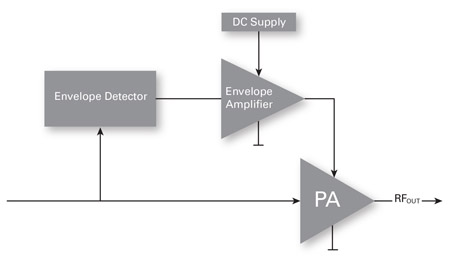
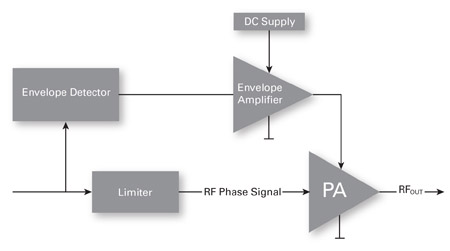
An ET system uses a linear PA whose power supply voltage follows the signal envelope to reduce thermal dissipation. In an EER system, the amplitude is eliminated from the RF signal. By controlling a switching PA, the amplitude is restored and high efficiency could be achieved. The two main challenges of ET and EER are high voltage, high efficient wide band envelope amplifier design and timing alignment between the envelope and the RF input signal. Both ET and EER suffer from performance degradation due to timing misalignment. EER especially has a very high requirement on timing alignment, which keeps it from being widely accepted by the industry, regardless of its high potential efficiency.
In this article, we analyzed multiple PA linearization solutions in terms of complexity, challenges and performance. While conventional linearization solutions, such as feed-forward linearization and Cartesian feedback, are still used in many applications, digital pre-distortion is becoming more widely accepted in wireless systems, especially in 3G and 4G base stations. ET and especially EER still have difficulties in implementation, but they are attracting more attention because of their high efficiency. www.idt.com